As we all know, there has been a 7-day exchange during the winter vacation of 2020. We twenty students, on behalf of the members of Civil Engineering, Chongqing University, left Chongqing on January 13th and returned to school on January 19 from Japan.
First day of communication
At 9 am of local time on January 14, 2020, Professor Wengang Zhang, deputy dean of the School of Civil Engineering, and Sun Jiaqi, a graduate counselor together with the students participated in this exchange camp to the Tokyo Institute of Technology. Professor Takeuchi delivered a warm welcome speech.

Prof. Takeuchi and Tamura Shuji delivered speeches
First, Professor Takeuchi gave a report on "Concepts of Seismic Energy Control" for the students. Professor Takeuchi introduced many design projects, development status, and research results of seismic design in Japan combining with many vivid examples. in a minute rofessor Tamura Shuji introduced the research on sand liquefaction in Japan to the students, so as to deepen the students' understanding of sand liquefaction through field experiment teaching. Afterwards, students and professors had a warm academic exchange and discussion. After the report, Professor Takeuchi took a guide tour of the university and introduced the long history and culture of Tokyo University of Technology to the students. After the morning tour, students and teachers had a group photo together.
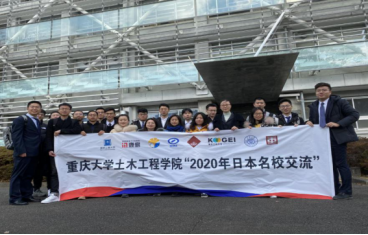
Group photo of Tokyo Institute of Technology
At 2 pm, our exchange group came to Kashima, Kashima Construction Corporation's Institute of Technology. The Kashima Construction Corporation Technology Research Institute was established in 1840 and enjoyed a high reputation in Western-style buildings, railway, dam construction, earthquake resistance construction and high-rise building construction. The Corporation has participated in many landmark projects design and construction in Japan, which played an important role in design and construction. The head of the corporation first introduced the basic situation of the corporation to the students in detail through the company's promotional video and PPT, and then took the exchange group to visit the shaking table laboratory, wind tunnel simulation laboratory and structure laboratory. After the visit, we took a group photo together in the hall of the institute.

Group photo of Kashima Construction Corporation Technology Research Institute
So far, the first day of exchange study has a successfully conclusion in Tokyo, Japan. This exchange trip not only deepened the students' understanding of the earthquake-resistant design of houses and related concepts of Japanese house design, but also allowed Chongqing University to establish deeper cooperation with Tokyo Institute of Technology and the Kashima Construction Company Technology Research Institute.
Exchange the next day
On January 15, 2020, under the arrangement and coordination of Academician Yukio Tamura of our college, the students of the School of Civil Engineering Winter Vacation Exchange Camp came to the University of Tokyo (Hono Campus). Nagayama Tomonori, the associate professor and Professor Qian Guowei, the assistant Professor, gave the exchange group a warm welcome and started exchange learning course.

Associate Professor NAGAYAMA Tomonori report scene

Professor Wengang Zhang's report site
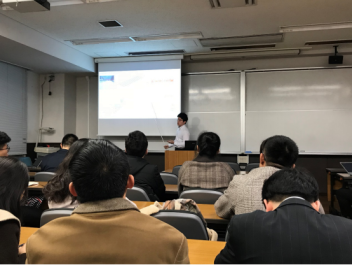
Dr. Kai Xue report scene
In the morning, Associate Professor NAGAYAMA Tomonori and Associate Dean of the School, Professor Wengang Zhang introduced the development history, school scale, faculty strength, training model, and major research results of the civil engineering disciplines of Tokyo University and Chongqing University, respectively. Subsequently, Dr. Kai Xue of the University of Tokyo introduced the design concept, development status, and research results of road damage detection in Japan under the title of "Dynamic Response Intelligent Monitoring System (DRIMS) for Road". This result integrates wireless sensing, imaging Recognition, genetic algorithms, Integrate other methods ,which realized the application of DRIMS technology with mobile phones as the carrier, making students feel the academic charm brought by interdisciplinary subjects more deeply.

Assistant Professor Qian Guowei's report
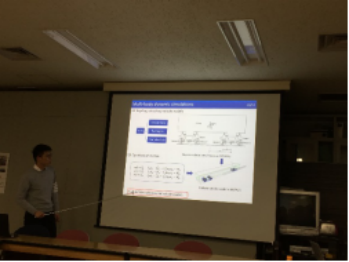
Dr. Dongqin Zhang report site
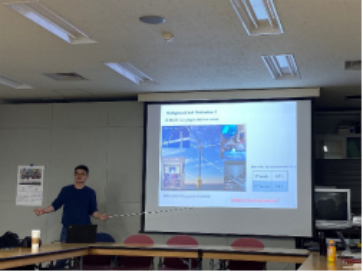
Dr. Lilin Wang report site
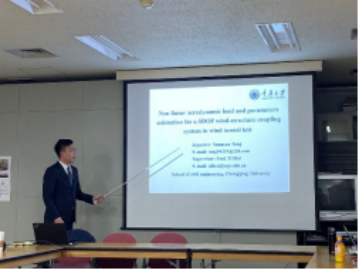
Field report of Dr. Yuanyuan Tang
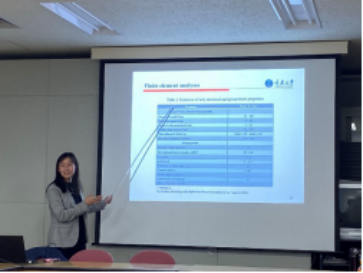
Scene of Dr. Runhong Zhang's report

The scene of Dr. Li Hang's postgraduate report
In the afternoon, Assistant Professor Qian Guowei introduced the organizational structure and development history of the Bridge and Wind Engineering Laboratory. Subsequently, Dr. Dongqin Zhang, Dr. Lilin Wang of the University of Tokyo, and Dr. Tang Yuanyan, Zhang Runhong, and Li Hang of Chongqing Unversity respectively had a report on their research topics and conducted exchanges and discussions on related issues. After the report, Assistant Professor Qian Guowei led the exchange camp teachers and students to visit the Geotechnical Engineering Laboratory and Wind Engineering Laboratory of the University of Tokyo. In the Geotechnical Engineering Laboratory, Associate Professor Kenji WATANABE and the research team explained the working principles and applications of related geotechnical engineering experimental equipment independently developed by the University of Tokyo, including unconfined triaxial apparatus, torsional shear triaxial apparatus, Moving the triaxial apparatus, etc., enabled students to deepen their understanding of experimental equipment and applications related to geotechnical engineering. In the wind engineering laboratory, Assistant Professor Qian Guowei explained the background and knowledge of the visual teaching wind tunnel and large-scale wind tunnel. The large-scale wind tunnel was built in 1964 and was originally designed for a full-scale bridge model. The maximum wind speed can reach 17m / s. It still serves the design of offshore wind turbines and the study of outdoor urban wind environment. Finally, Assistant Professor Qian Guowei also allowed everyone to experience the wind field effect during the operation of a large wind tunnel at the wind tunnel experimental section. After the visit, we had a group photo in front of the teaching wind tunnel.
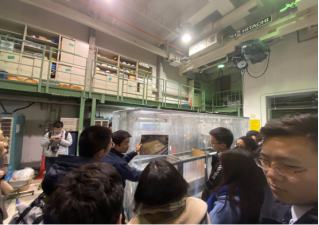
Associate Professor Kenji WATANABE gave a live explanation

Photos of the visit of the Geotechnical Engineering Laboratory
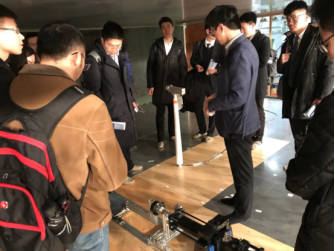
Photo of the site of the wind engineering laboratory visit

Taking a group photo at the scene
So far, the second day of exchange study in the Winter Vacation Exchange Camp of the School of Civil Engineering of Chongqing University was successfully concluded in Tokyo, Japan. This exchange tour enabled students to deepen their knowledge of road damage detection technology and the impact of tornadoes on the stability of train operation, and learned about Japan's cutting-edge technology and scientific exploration in the field of bridges and wind engineering.
The third day of communication
On the morning of January 16, 2020, the exchange group visited Shimizu Construction Co., Ltd., Japan. Firstly, the assistant Aku gave students a preliminary understanding of Shimizu Construction through PPT. The Qingshui Construction Research Institute involved civil engineering, construction, machinery, medicine and other directions. After that, the students were divided into two groups to visit the park.
In the wind tunnel laboratory Aku explained the basic situation of the wind tunnel laboratory, modeled the experimental process and led the students to experience the wind field effect at a speed of 30m / s. In the material laboratory, everyone learned about the mechanization of the building. The use of robots during the construction process, and actually visited the samples of the new concrete to understand its development process, tending to be safe and sustainable. In the end, Aku showed the students the difference between shock-absorbing, earthquake-resistant and isolated buildings through models in the main building.

The engineer of Shimizu Construction adopted the actual engineering case of earthquake-resistant renovation of the Western Art Museum of Japan, and introduced the method of isolation based on inheritance, protection, and functionality.
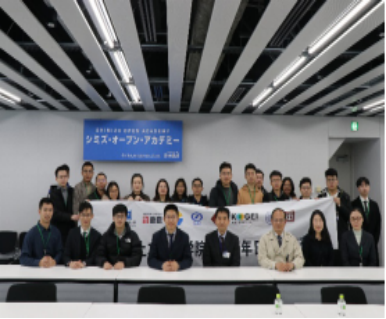
At noon that day, on the way to Waseda University, our exchange group met the group of Jilin University. We came to exchange and had a profound exchange.
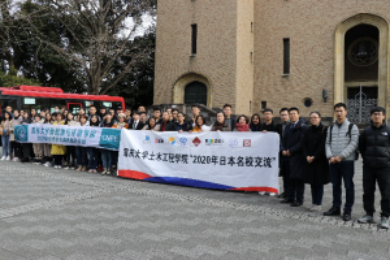
Group photo of Waseda University
In the afternoon, Professor Akira NISHITANI introduced Waseda University and its research experience. Waseda University was established in 1882 and it is one of the oldest universities in Japan. After that, it made an "Enhancement of resilience for tokyo metropolitan area: preparing for severe seismic event. The report is about the Tokyo resilience project shaking table test of 2018-2021 chaired by Professor NISHITANI. Afterwards, the professor had the exchange group a tour of the Waseda University. The third day of the exchange study in the Winter Vacation Exchange Camp of the School of Civil Engineering of Chongqing University was successfully concluded in Tokyo, Japan.
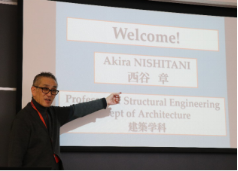
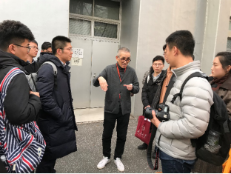
Professor Akira NISHITANI gave a lecture and campus introduction
Fourth day of communication
On January 17, 2020, today's visit and exchange activities focused on Tokyo Institute of Technology (TPU). The exchange group first arrived at Tokyo Institute of Technology (TPU) Atsugi campus.
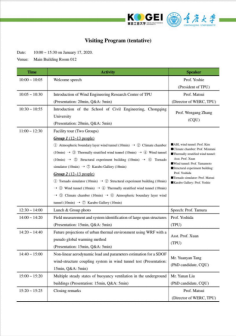
Tokyo University of Technology itinerary
First of all, Professor Yoshie, the principal of TPU, gave a short speech, introduced the basic situation of the school, and warmly welcomed the arrival of the Chongqing University exchange group.
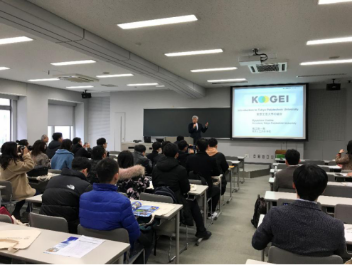
TPU Principal Professor Yoshie gave a speech
Subsequently, Professor Matsui, director of the TPU Wind Engineering Research Center, introduced the basic situation of the research center. As one of Japan's MEXT projects, the research center is strong and has achieved fruitful research results, including wind resistance projects in some venues of the 2020 Tokyo Olympics.
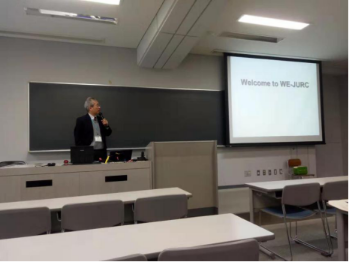
Professor Matsui,
Director of TPU Wind Engineering Research Center, gave a speech
Later, Professor Wengang Zhang, deputy dean of the School of Civil Engineering of Chongqing university, introduced the history and culture of Chongqing, the development history of Chongqing University, and the wind engineering team of the School of Civil Engineering of Chongqing University.
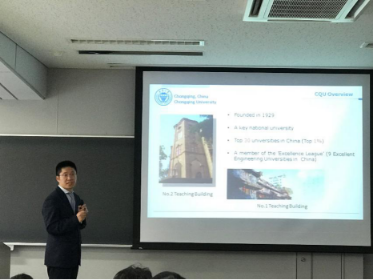
Professor Wengang Zhang introduced
the School of Civil Engineering, Chongqing University
Afterwards, the members of the camp visited the relevant laboratories. Under the explanation of the laboratory leaders, everyone had a detailed understanding of the test principle and test process. The labs visiting included a tornado simulator, a structural laboratory, a wind tunnel laboratory, a thermal layered wind tunnel, a climate laboratory, an atmospheric boundary layer wind tunnel, and a Col laboratory gallery.

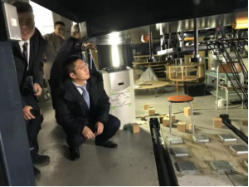
Students visit the laboratories
After the lab visit, Academician Yukio Tamura prepared a Japanese lunch for everyone.

Group photo of teachers and students of the two schools

Professor Tamura Yukio speaks
After lunch, under the leadership of Professor Matsui (Director of WERC, TPU), the exchange group visited the residential buildings, farmland cultivation, and historical sites around Tokyo Institute of Technology, and learned more about the integration of humanities and architectural arts in Kanagawa status.
After the visit, Professor Yoshida of TPU introduced the field measurement and system identification of large span structures, and introduced the related research methods of environmental vibration experiments and modal identification of large-span spatial structures. For example, it introduces in detail how to select a node to arrange a three-axis accelerometer, measure the time domain function of acceleration and time parameters, and convert the time domain function into a frequency domain function under the fast Fourier transform (FFT) method to extract power. The peak value of the spectral density function and the effective modal identification method for identifying the modal frequencies, damping ratios and formations of large-span spatial structures, laying a solid foundation for the accuracy and reliability of structural damage detection in the later stage. Professor Yoshida's explanation made students have a certain understanding of cross-research projects such as structural health monitoring (SHM), integrated signal processing, sensor elements, and finite element simulation.
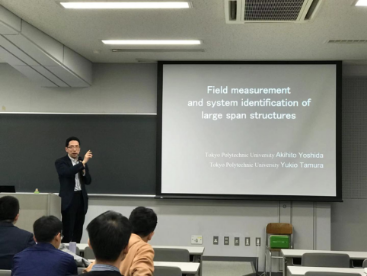
Professor Yoshida report
Associate Professor Xuan introduced the future prediction of urban thermal environment under the title "Future projections of urban thermal environment using WRF with a pseudo global warming method". Her report included the climate change, the thermal impact of rising thermal environments on the health of urban residents, machine learning, and data analysis of future thermal environmental trends.

Report by Associate Professor Xuan
Later, two doctors, Tang Yuanyan and Liu Yanan, from Chongqing University reported on their research topics respectively. The identification method that can be used in single degree of freedom system is introduced in detail. This identification method can obtain the system aerodynamic damping, aerodynamic stiffness, and system self-excitation through measured data during the test, such as system acceleration or displacement; Liu Yanan took the topic of "Multiple steady states of buoyancy ventilation in the underground buildings", This paper introduces the phenomenon of hot-pressurized ventilation polymorphism in underground buildings, the formation mechanism research, and the deduction and application of stability and existence criteria.
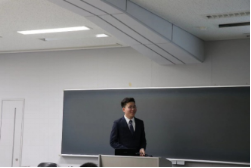
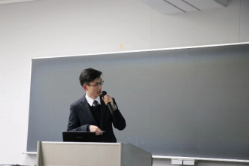
Report by Dr. Yuanyuan Tang and Dr. Yanan Liu from our hospital
After the exhibition, Professor Wengang Gang presented the screen with the characteristics of Chongqing University to the Tokyo Institute of Technology on behalf of the School of Civil Engineering of Chongqing University. The screen is engraved with the school building and the school motto. Progress and the friendship between the two schoolsare lasting!

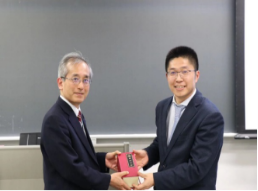
Gift giving
At this point, the exchange visit between Chongqing University Exchange Camp and Tokyo Institute of Technology was successfully concluded!
During the 7 days, it didn't take long to say, but every student was very productive. Everyone has a comprehensive and profound understanding of Japan from all aspects on history, culture, urban construction, transportation, food, academic attitude and atmosphere. This event broadened the students' international horizons and improved their communication, expression and communication skills in various aspects. I do believe that our college will encounter a new round development through the extensive exchane of similar events in the future.
